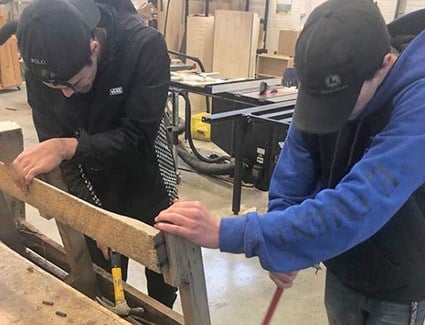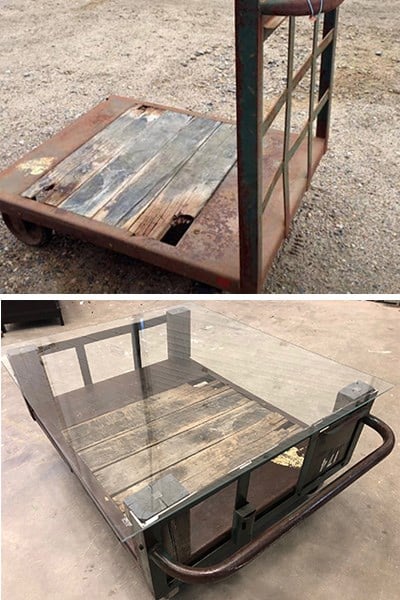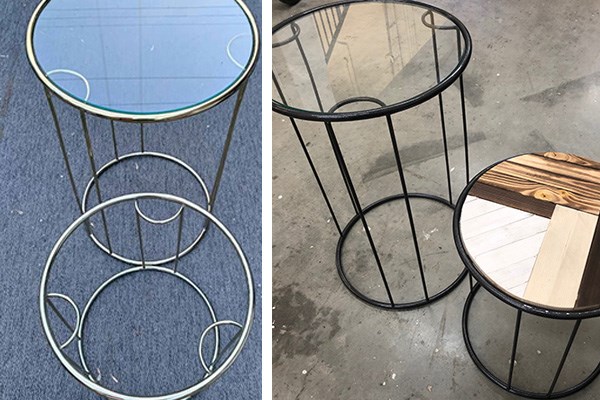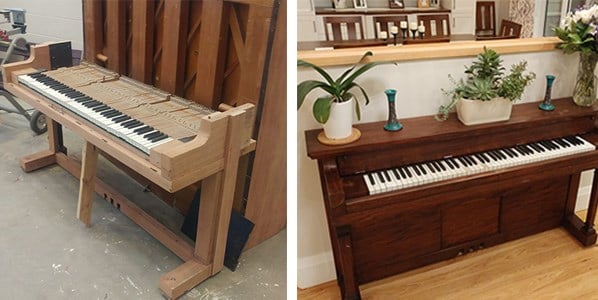 Providing students with the skills and opportunity to build something from scratch has always been a goal of wood shop courses at Tommy Douglas Collegiate.
Providing students with the skills and opportunity to build something from scratch has always been a goal of wood shop courses at Tommy Douglas Collegiate.
But for the past few years students in teacher Andrea Calow's intermediate woodworking class have also received a lesson in how to transform an old or unwanted piece of furniture into something they can sell for a profit.
Repurposing is a popular trend in home décor. Do-it-yourself television shows highlight the ways in which old or obsolete items can be turned into something unique and stylish, but the concept is often new to students.
"When you say repurpose or upcycle to a new group of students, they don't often know exactly what to expect – they haven't seen it," Calow said. "I start by showing them an episode of a television show like Flea Market Flip and by the end they say 'Oh, that's what it means' and they often get really excited about – especially when you tell them that their profit is 100 per cent theirs.
"This project puts the onus on the students. They have to go out and find something, whether that is in grandma's basement or if it's their old coffee table. I also show them how to look on Kijiji and marketplace and even the free curbside days. It can be daunting for some of them; the door is so wide open that they don't know where to start."
The projects students create from leftover or unwanted objects are inspired by their own imagination, research into repurposing trends and techniques and, ultimately, the source material they have found.
 One of the most successful creations from last semester was a metal cart that was transformed into a glass-top coffee table — something immediately purchased by an appreciative parent . A bar-height table created from metal pipe, reclaimed wood and the grill of an old truck was another success, while a bed frame footboard and headboard were transformed into an upholstered bench. In past years, students have transformed a wide variety of items, including a pair of unwanted pianos.
One of the most successful creations from last semester was a metal cart that was transformed into a glass-top coffee table — something immediately purchased by an appreciative parent . A bar-height table created from metal pipe, reclaimed wood and the grill of an old truck was another success, while a bed frame footboard and headboard were transformed into an upholstered bench. In past years, students have transformed a wide variety of items, including a pair of unwanted pianos.
Students begin their semester of intermediate woodworking by first acquiring the technical knowledge and skills to design and construct a cabinet. Then, those skills and experience are applied to the repurposing project that concludes the semester.
"I like to watch trends in woodworking, and you are seeing repurposing happen around the community. The idea really it came about by just trying to put together an interesting class for the kids," Calow said. "Not just a pure carpentry and construction stream, but where you are mixing in design and other classes."
The repurposing project helps meet curricular goals by providing students with the opportunity to learn skills including design, upholstery, wood refinishing and other techniques. That complements the more traditional cabinet-making component of the course.
Calow presents the repurposing project to students as both a challenge and an opportunity. Sourcing the necessary article or materials is the obvious challenge, but having a vision for the end product, persevering and adapting when required, and then advertising and selling their finished project is all part of the process.
The potential reward, of course, is recouping any initial investment in their piece by selling it, whether to a parent or family member or to someone who discovers the piece through an online marketplace, social media or personal contacts.
 "In a world where we promote repurposing or recycling, I think it is such an important idea to show them how this old stuff could be something new," Calow said. "You know you have done really well when you have kept something out of the dump and made something that people really want. And it doesn't hurt to make a profit while you do that!"
"In a world where we promote repurposing or recycling, I think it is such an important idea to show them how this old stuff could be something new," Calow said. "You know you have done really well when you have kept something out of the dump and made something that people really want. And it doesn't hurt to make a profit while you do that!"
While some students embrace the freedom offered by the repurposing project, Calow said there are others who struggle when pushed out of their comfort zone by being asked to do more than just follow a plan and directions provided by a teacher.
"It is really about teaching them how to get outside (that box) and asking how they can do this for themselves," she said. "That is one of the big things for me, showing them that they don't need to be in Woods 30 in the school shop to be able to do this successfully. I have students who can do this kind of thing at home to make some money on the side."
In addition to wood shop, Tommy Douglas provides practical and applied arts courses in areas ranging from robotics and residential construction to interior design and food studies. While the projects they complete are an indicator of successful learning, the skills students are learning in practical and applied arts courses are important for their future.
"I think for all of us who teach in the industrial arts really what it comes down to is the soft skills," Calow said. "If you ask a cabinetry company what they want from our students when they come out (of school) they don't say they want somebody who can work a saw or is comfortable with a drill press, they want a kid who shows up on time, a kid who focuses all day, a kid who can problem-solve. Those are the skills that are behind everything you see."
"Every class and every subject are trying to instill these values, but industrial arts and home economics are all about the real world and the skills that you will need," she said. "Sometimes students get that right away, and sometimes you'll hear back from a student three years after they have graduated that they have now been able to connect what they have learnt to their success as a citizen in the community."
